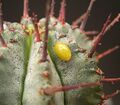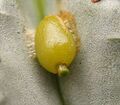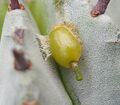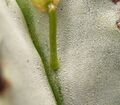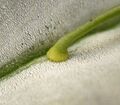Biology:Viscum minimum
| Viscum minimum | |
|---|---|

| |
| Viscum minimum leaf scales and flowers emerging from the host plant. | |
| Scientific classification | |
| Kingdom: | Plantae |
| Clade: | Tracheophytes |
| Clade: | Angiosperms |
| Clade: | Eudicots |
| Order: | Santalales |
| Family: | Santalaceae |
| Genus: | Viscum |
| Species: | V. minimum
|
| Binomial name | |
| Viscum minimum | |
Viscum minimum is a species of mistletoe in the family Santalaceae. It is a parasitic plant native to South Africa .
Description
In its native habitat Viscum minimum uses two species of succulents, Euphorbia polygona and Euphorbia horrida, as host plants. However, given the opportunity, the plant uses a range of succulents, including cacti, as hosts.
A mature Viscum minimum consists mostly of haustoria within the host plant, but a small stems of less than one millimeter in length with a single whorl of 2-3 scale-like leaves. A single flower, and later a red round fruit with a diameter of 8-9 millimeters, emerges from these stems. The leaves and stems are capable of photosynthesis, making the plant technically a hemiparasite.
The Viscum minimum mitochondrial genome has been sequenced, showing an unusual loss of genes or their functions. [1]
Seed germination
Day 30: The primary haustorium has developed.
Literature
- William Henry Harvey: Flora Capensis 2: 581
- Robert Allen Dyer: Two Rare Parasites on Succulent Species of Euphorbia, Euphorbia Review Vol. I (4): 29-32, 1935
- Thomas Goebel: Viscum minimum Harvey in der Sukkulentensammlung der Stadt Zürich, Kakteen und andere Sukkulenten 29 (1), 1978
- Frank K. Horwood: Two parasites of Euphorbia: Viscum minimum and Hydnora africana, The Euphorbia Journal, Vol 1: 45-48, 1983
References
Wikidata ☰ Q244253 entry
 |
